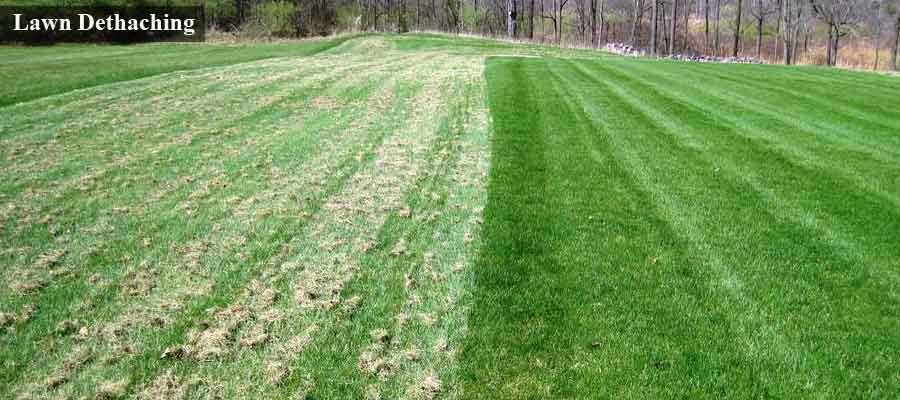Spring is here and it's time to start thinking about your lawn and landscaping needs. Here are a few services to consider this Spring and why they are so beneficial to your lawn.
Visit our website today to signup for these services and more.
website: markslawnserviceinc.com
Spring Cleanup / De-thatching
Why should I de-thatch?
Benefits of De-thatching...
Thatch, in your lawn, is no more than a layer of dead grass – or plant material – that includes roots, grass and leaves, which lay on the surface of the soil. While some may consider it a “compost” material, it is actually a decomposing plant material that can suffocate your lawn. To ensure a healthy lawn after a long and cold winter, it is important to expose the soil to warmth and sunlight. The best way to do this is to de-thatch your lawn. De-thatching provides many benefits, including:
Healthy Root Growth in Your Grass...
If you have a build up of thatch, healthy root growth is nearly impossible. If the roots aren’t healthy, your grass will never become full, green and thick. By de-thatching, you are able to help circulate air deep down into the roots, and providing necessary carbon dioxide. Not only does this stimulate existing roots, but also encourages new root growth.
Making Fertilizer Work for Your Lawn...
If there is a thatch build up on your lawn, applied fertilizers cannot properly blend with the soil. De-thatching ensures that your fertilizers are able to work effectively, and spread properly across
your lawn and throughout the soil.
Effective Draining...
Again, thatch is essentially a barrier between the soil and anything healthy that needs to come in contact with it. While moisture is necessary for proper lawn growth, it can become a damaging factor when it’s unable to penetrate the soil and make its way to the roots. With a healthy lawn, the moisture remains on the surface for a short time, eventually draining into the soil and to the root system. If thatch is present, however, water remains at the surface for a longer period of time, and saturates the plant system. De-thatching will ensure that water drains properly, while also nurturing your lawn.
Aeration
What is aeration, and why should I aerate my lawn?
Aeration involves perforating the soil with small holes to allow air, water and nutrients to penetrate the grass roots. This helps the roots grow deeply and produce a stronger, more vigorous lawn.
The main reason for aerating is to alleviate soil compaction. Compacted soils have too many solid particles in a certain volume or space, which prevents proper circulation of air, water and nutrients within the soil. Excess lawn thatch or heavy organic debris buried under the grass surface can also starve the roots from these essential elements.
Should You Be Aerating Your Lawn?
One of the most common questions from homeowners is how to determine if they should be aerating their lawn. Your lawn is probably a good candidate for aeration if it:
-Gets heavy use, such as serving as the neighborhood playground or racetrack. Children and pets running around the yard contribute to soil compaction.
-Was established as part of a newly constructed home. Often, the topsoil of newly constructed lawns is stripped or buried, and the grass established on subsoil has been compacted by construction traffic.
-Dries out easily and has a spongy feel. This might mean your lawn has an excessive thatch problem. Take a shovel and remove a slice of lawn about four inches deep. If the thatch layer is greater than one-half inch, aeration is recommended.
-Was established by sod, and soil layering exists. Soil layering means that soil of finer texture, which comes with imported sod, is layered over the existing coarser soil. This layering disrupts drainage, as water is held in the finer-textured soil. This leads to compacted conditions and poor root development. Aerating breaks up the layering, allowing water to flow through the soil more easily and reach the roots.
When to Aerate Your Lawn
The best time for aeration is during the growing season, when the grass can heal and fill in any open areas after soil plugs are removed. Ideally, aerate the lawn with cool season grass in the early spring or fall.
Core aeration can help make your lawn healthier and reduce its maintenance requirements through these means:
-Improved air exchange between the soil and atmosphere.
-Enhanced soil water uptake.
-Improved fertilizer uptake and use.
-Reduced water runoff and puddling.
-Stronger turf-grass roots.
-Reduced soil compaction.
Fertilizing
Why should I fertilize my lawn?
There are several reasons why you would need to fertilize your lawn. Over time, many lawns will leech nutrients out of their soil. Most nutrients for your lawn are water-soluble. Over time, whether through rain or irrigation, the water will carry these nutrients out of your lawn. This will leave your lawn nutrient deficient, which will leave you with an unhealthy lawn susceptible to disease. In some instances, the soil that the grass is growing in does not have the naturally occurring nutrients that turf needs to grow. If this is the case, fertilizer will be needed in order to maintain a healthy lawn. It is best to fertilize with a crabgrass pre-emergent in the early spring to help reduce the germination of crabgrass during the growing season. If crabgrass does germinate, you can request to have that eliminated by adding a chemical called drive into our 2nd herbicide application in July/August.





